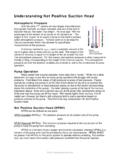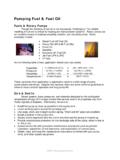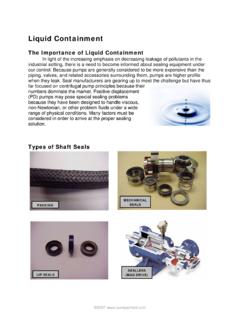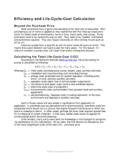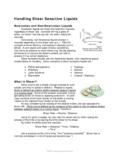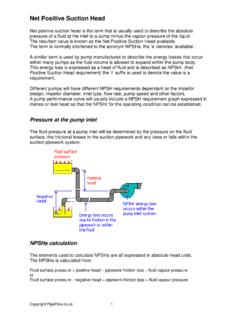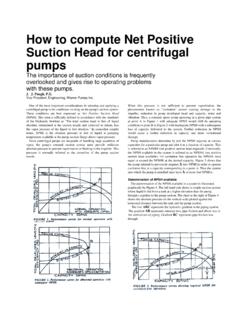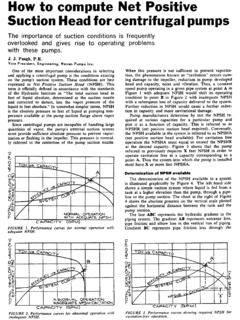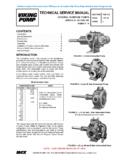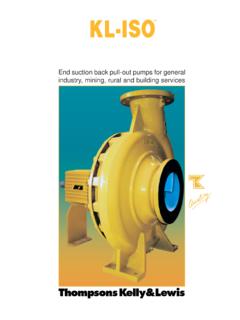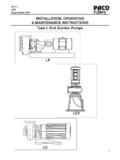Transcription of When to use a Positive Displacement Pump
1 When to use a Positive Displacement Pump When to use a centrifugal or a Positive Displacement pump ( PD Pump ) is not always a clear choice. To make a good choice between these pump types it is important to understand that these two types of pumps behave very differently. Flow rate versus pressure By looking at the performance chart to the ryou can see just how different these pumpare. The centrifugal has varying flow depending on pressure or head, whereas the PD pump has more or less constant flow regardless of pressure. ight s ate chart how the centrifugal pump only the e fficiency versus pressure n By e Performance050100150200250050100150 Capacity GPMHead FeetPositive Centrifugal Flow rate versus viscosity Another major difference between the pump types is the effect viscosity has on the capacity of the pump. You will notice in the flow rloses flow as the viscosity goes up but the PD pump s flow actually increases. This is because the higher viscosity liquids fill the clearances ofthe pump causing a higher volumetric efficiency.
2 Remember, this chart showseffect of viscosity on the pump flow; when thereis a viscosity change there is also greater linloss in the system. This means you will also have to calculate the change in pump flow from the first chart for this pressure change. Flow Rate40%50%60%70%80%90%100%0100 200 300 400 500 Viscosity cStPercentPositiveCentrifugalE Efficiency - Head40%45%50%55%60%65%70%75%80%5580105 Feet of HeadPercentPositiveCentrifugalThe pumps behave very differently wheconsidering mechanical efficiency as at the efficiency chart to the right you can see the impact of pressure changes on thpump s efficiency. Changes in pressure have little effect on the PD pump but a dramatic oneon the centrifugal. 2007 Efficiency versus viscosity pump eed, l et Positive suction Head Requirements varies as a function of flow, ed perating at different points on the curve of pumps is that a left or a ue he data presented in these charts is the actual data for a specific application.
3 The will Efficiency - Viscosity0%20%40%60%80%100%0250500750 1000 Viscosity cStPercentPositiveCentrifugalViscosity also plays an important role in mechanical efficiency. Because the centrifugal pump operates at motor spefficiency goes down as viscosity increasesdue to increased frictional losses within the pump. Efficiency often increases in a PD pump with increasing viscosity. Note how rapidly efficiency drops off for the centrifugapump as viscosity increases. NAnother consideration is NPSHR. In a centrifugal the NPSHR which is determined by pressure and viscosity as discussed above. In a PD pump, NPSHR varies as a function of flow which is determined by speed. The lower the speof a PD pump, the lower the NPSHR. OAnother thing to keep in mind when comparing the two types centrifugal pump does best in the center of the curve. As you move either to the right, additional considerations come into play. If you move far enough to the left or right, pump life is reduced due to either shaft deflection or increased cavitation.
4 WithPD pump you can operate the pump on any point of the curve. In fact the volumetric efficiency as a percent actually improves at the high speed part of the curve. This is dto the fact that the volumetric efficiency is affected by slip, which is essentially constant. At low speed the percentage of slip is higher than at high speed. Tcentrifugal was picked at its Best Efficiency Point (BEP) and the PD pump (Internal Gear) was selected to match the flow, viscosity, and pressure. Different applicationshave different curves and efficiencies. These curves are presented as an example of the performance behavior differences of the two pump principles. 2007 Pump Selection Scenarios ing of the performance differences between g igh Viscosity As illustrated by the graphs above, even modest viscosities dramatically Now that you have a clearer understandthese two pump principles, when would you choose to use a PD pump? The followinchart lists several such scenarios.
5 Haffect the flow rate and efficiency of a centrifugal pump. While many centrifugals are cataloged to 1,000 cSt and higher, PD pumps are clearly the better choice when considering the high energy costs resulting from this lost efficiency. Operating f hen being run too far off the middle of result Away from the Middle othe Curve Centrifugals do not operate well wthe curve. At best, this results in reduced efficiency which would require larger motors and higher energy costs. At worst, this can in cavitation damage, shaft deflection, and premature pump failure. PD pumps on the other hand can be run at any point on their curve without damaging the pump or greatly affecting the efficiency. Variations in ven modest . , . Pressure The first graph above clearly illustrates the effect that echanges in pressure can have on the flow rate of a centrifugal pumpAdditional restrictions such as debris in a filter, corroded / rough pipingor a valve left too far closed (or too far open) can have a dramatic effect on a centrifugal pump s flow rate and efficiency.
6 PD pumps maintain their flow rate and efficiency even with significant changes in pressureVariations in w e Viscosity Many liquids vary in viscosity depending on temperature or due to chemical reaction. A rise in viscosity will independently alter the florate and efficiency. Add to that the rise in pressure due to the increasin frictional line losses and PD pumps become the clear choice for variable viscosity applications. High ures run in series to boost their pressures, res PressWhile some centrifugals can benone can compete with PD pumps for high pressure applications. Pressure limits will depend on the design of each pump, but pressuof 250 PSI (580 feet) are not unusual for a PD pump, with some modelsgoing over 3,000 PSI (7,000 feet). The capability for a PD pump to produce pressure is so great that some type of system overpressureprotection is required. Shear e mps tend to shear liquids more as speed is SensitivLiquids Generally speaking, puincreased and centrifugals are high speed pumps .
7 This makes PD pumps better able to handle shear sensitive liquids. suction Lift let side, making that ApplicationsBy their nature, PD pumps create a vacuum on the inthem capable of creating a suction lift. Standard ANSI centrifugals do not create a vacuum and cannot create a suction lift. There are self-priming centrifugal designs that can lift liquid an average of 15 feet when partially filled (13 hg vacuum). Many dry PD pumps can pull or better and wetted PD pumps (a pump that is not full of liquid but with some liquid in it) can often reach vacuums of 25 to 28 hg. PD pumps are the logical choice when a suction lift is required. 2007
